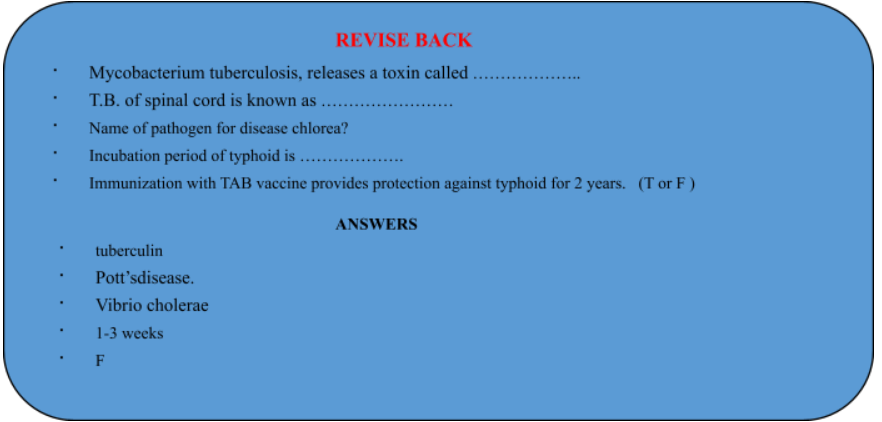Communicable Diseases
Human Health And Diseases of Class 10
COMMUNICABLE DISEASES
-
Diseases caused by bacteria
- TUBERCULOSIS (T.B.)
It is a communicable disease. It is of two types: pulmonary and extra-pulmonary (i.e., intestinal, bone, skin, meninges). The disease primarily affects lungs and this is called lung (or pulmonary) tuberculosis.
The diseases can also affect lymph glands, often in the legs and this is called lymph gland tuberculosis. TB can affect all parts of the body.
Pathogen :Mycobacterium tuberculosis, releases a toxin called tuberculin.
Transmission
Mode of infection : The sputum, throat and nose discharge of person suffering from tuberculosis are the infection materials. Infection may be transmitted by :
- Direct contact : When a patient coughs, droplets containing bacteria are exhaled by him which may be inhaled by a healthy person talking to him or standing near him.
- Indirect contact : by using articles like spoon, handkerchief, towel, etc. used by the patient.
Incubation period : range from few weeks to few years.
Tuberculosis was first discovered by Robert Koch in 1882.
Symptoms :
Depend upon the organs infected with the disease
- In pulmonary infection, acute chest pain and difficulty in breathing.
- Fever in evening with persistent cough and haemoptysis (sputum with blood).
- Loss of weight as this bacteria breaks protein at large scale, night sweating.
T.B. of spinal cord is known as Pott’sdisease. Mycobacterium tuberculosis
- In bone infection loss of bone weight and persistent pain.
- In intestinal infection persistent diarrhoea, indigestion.
- In lung T.B., following symptoms are seen :
- Cough may be the earliest symptom.
- Typical low grade fever pattern and sweating at night, continuing for a long time.
- Pain in the chest.
- Blood in the sputum.
- A feeling of weakness, and loss of appetite and weight.
- Feeling out of breath on exertion.
- In lymph gland T.B., there may be swelling of the lymph nodes; the lymph glands may discharge secretions through the skin.
Diagnosis
Sputum examination for the presence of bacteria for all patients showing any of the following symptoms :
- Cough lasting for more than four weeks
- Continuous fever
- Chest pain
- Blood in the sputum
CHOLERA
Cholera is an acute infectious disease of gastro-intestinal tract. Outbreaks of the disease are common at fairs, pilgrimages and after floods and it affects all age groups.
Name of Pathogen :Vibrio cholerae.
Incubation period : Few hours to 2-3 days.
Symptoms:
Acute diarrhoea with profuse watery stool, vomiting, rapid dehydration, muscular cramps and anuria.
Appear in three stages:
- First stage (Stage of evacuation) severe attack of diarrhoea, headache, vomiting and colic pain; upto 40 painful evacuation/day.
- Second stage (Stage of collapse) sunken eyes, hollow cheeks, bluish colour (cyanosis); subnormal temperature, shallow and quick breathing, loss of urination, severe pain in abdomen and cramps.
- Third stage (Stage of recovery) acute symptoms of previous stage subside. Blood pressure, body temperature and urine secretion return to normal. Inflammation of kidneys, lungs and intestine.
Transmission
- It is spread by ingestion of contaminated food and water.
- Flies also spread it by carrying the infection from contaminated food or wastes to the food consumed by other people.
- It is spread rapidly in areas where sanitation is poor.
TYPHOID
Typhoid is an acute infectious disease of alimentary canal and blood which is most common communicable diseases in India. It is common in children in the age group of 1-15 years.
Pathogen :Salmonella typhi (Anaerobic, flagellate bacillus)
Incubation period :1-3 weeks.
Though the disease occurs throughout the year but the frequency is higher during the rainy season.
Symptoms
- High fever in the second week, gradually declines in the third and fourth week.
- Red rashes developed on upper abdomen at the end of the first week.
- In untreated cases, patient may develop haemorrhage from an ulceration in the small intestine.
- Characterised by continuous fever which increases day by day in the first week and is higher in the afternoon than in the morning.
- Fever is accompanied with headache.
Transmission
- Through food, milk and water contaminated with faeces either directly or through flies.
- Spread chiefly by ingestion of contaminated food, water, milk, milk products and unwashed raw vegetables.
- The bacteria are excreted in the stools and urine of patients. Defecation and urination in the open leads to spread of infection through soil, food, water and flies.
- Spread also takes place through direct contact with the patient.
Prevention and Control
- Proper community sanitation, safe water supply and food sanitation should be ensured.
- Breeding of flies should be prevented by the use of insecticides and wire mesh doors and windows.
- Immunization with TAB vaccine provides protection against typhoid for 3 years.
- Live oral vaccines against typhoid are also available.
- The patient, being a source of infection, should be isolated and his stools and urine should be collected in closed container and disinfected before disposal by flushing or burning.
- Patient’s personal clothing, bed clothes should be disinfected by boiling.
- Persons attending on the patient should disinfect their hands.










